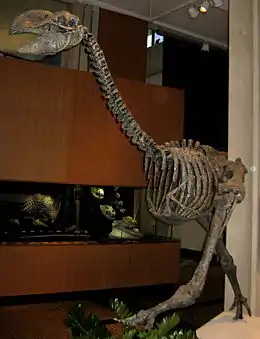Дроморнісові
Дроморнісові (Dromornithidae) — родина викопних птахів ряду Гусеподібні (Anseriformes), що існувала протягом олігоцену-плейстоцену в Австралії та Тасманії. Це, в основному, велетенські хижі птахи. Найбільші представники родини — Dromornis australis та Dromornis stirtoni, сягали 2,5 м завдовжки та 500 кг ваги. Вид Genyornis newtoni був відомим австралійським аборигенам і вимер 11 тис. років тому. Серед причин зникнення родини у плейстоцені розглядають зміну клімату, лісові пожежі та полювання людини.
? ДроморнісовіЧас існування: Олігоцен - Плейстоцен (25 —0,03 млн років тому) | ||||||||||||||||||
|---|---|---|---|---|---|---|---|---|---|---|---|---|---|---|---|---|---|---|
 Dromornis stirtoni | ||||||||||||||||||
| Біологічна класифікація | ||||||||||||||||||
| ||||||||||||||||||
Роди | ||||||||||||||||||
|
†Dromornis (type) | ||||||||||||||||||
Посилання | ||||||||||||||||||
| ||||||||||||||||||
Етимологія
Наукова назва — Dromornithidae, походить від грецького: dromaios (швидкий бігун), та ornis (птахи).
Класифікація
Раніше родину вважали близькою до ему та казуарів, але дослідження останніх років показали близькість до паламедеєвих (Anhimidae), тому родину віднесли до ряду гусеподібні. Відомо 7 видів у 5 родах:
- Dromornis australis †
- Dromornis stirtoni †
Див. також
Література
- Field J.H. & Boles W.E. Genyornis newtoni and Dromaius novaehollandiae at 30,000 b.p. in central northern New South Wales // Alcheringa. — 1998. — Vol. 22. — P. 177–188.
- Murray P.F. & Megirian D. The skull of dromornithid birds: anatomical evidence for their relationship to Anseriformes (Dromornithidae, Anseriformes) // Records of the South Australian Museum. — 1998. — Vol. 31. — P. 51-97.
- Murray P.F. & Vickers-Rich P. Magnificent Mihirungs: The Colossal Flightless Birds of the Australian Dreamtime // Indiana Univ. Press, 2004.
- Miller G.H. Magee, Johnson J.W., Fogel B.J., M. L. Spooner, N. A. McCulloch, M. T. & Ayliffe, L. K. Pleistocene extinction of Genyornis newtoni: human impact on Australian megafauna // Science. 1999. - Vol. 283. - P. 205–208. DOI:10.1126/science.283.5399.205
- Rich, P. (1979) The Dromornithidae, an extinct family of large ground birds endemic to Australia. Bulletin of the Bureau of Mineral Resources, Geology and Geophysics 184: 1-190.
- Rich, P. & Gill, E. (1976) Possible dromornithid footprints from Pleistocene dune sands of southern Victoria, Australia. Emu 76: 221–223.
- Rich, P. & Green, R. H. (1974) Footprints of birds at South Mt Cameron, Tasmania. Emu 74: 245–248.
- Roberts, R. G. Flannery, T. F. Ayliffe, L. A. Yoshida, H. Olley, J. M. Prideaux, G. J. Laslett, G. M. Baynes, A. Smith, M. A. Jones, R. & Smith, B. L. (2001) New ages for the last Australian megafauna: continent-wide extinction about 46,000 years ago. Science 292: 1888–1892. DOI:10.1126/science.1060264
- Vickers-Rich, P. & Molnar, R. E. (1996) The foot of a bird from the Eocene Redbank Plains Formation of Queensland, Australia. Alcheringa 20: 21-29.
- Williams, D. L. G. (1981) Genyornis eggshell (Dromornithidae; Aves) from the Late Pleistocene of South Australia. Alcheringa 5: 133–140.
- Williams, D. L. G. & Vickers-Rich, P. (1992) Giant fossil egg fragment from the Tertiary of Australia. Contributions to Science, Natural History Museum of Los Angeles County 36: 375–378.